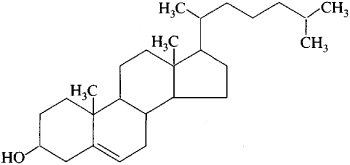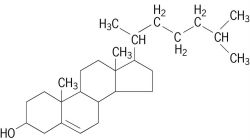cholesterol
Cholesterol
A cyclic hydrocarbon alcohol commonly classified as a lipid because it is insoluble in water but soluble in a number of organic solvents. It is the major sterol in all vertebrate cells and the most common sterol of eukaryotes. In vertebrates, the highest concentration of cholesterol is in the myelin sheath that surrounds nerves and in the plasma membrane that surrounds all cells. See Lipid
Cholesterol can exist either in the free
(unesterified) form (see structure below) or in the esterified form, in which a fatty acid is bound to the hydroxyl group of cholesterol by an ester bond. The free form is found in membranes. Cholesteryl esters are normally found in lipid droplets either within the cells of steroidogenic tissues, where it can be converted to free cholesterol and then to steroid hormones, or in the middle of spherical lipid-protein complexes, called lipoproteins, that are found in blood. See Cell membranesCholesterol, together with phospholipids and proteins, is important in the maintenance of normal cellular membrane fluidity. At physiological temperatures, the cholesterol molecule interacts with the fatty acids of the membrane phospholipids and causes increased packing of the lipid molecules and hence a reduction of membrane fluidity. Thus, all vertebrate cells require cholesterol in their membranes in order for the cell to function normally. Cholesterol is also important as a precursor for a number of other essential compounds, including steroid hormones, bile acids, and vitamin D. See Lipid metabolism; Steroid
Cellular cholesterol is obtained both from the diet, following its absorption in the intestine, and from synthesis within all cells of the body. Foods that are particularly high in cholesterol include eggs, red meat, and organs such as liver and brain. About 40–50% of the dietary cholesterol is absorbed from the intestine per day. In contrast, plant sterols are very poorly absorbed. Cholesterol synthesis occurs in all vertebrate cells but is highest in the liver, intestine, and skin, and in the brain at the time of myelination.
Cholesterol and cholesteryl esters are essentially insoluble in water. In order to transport these compounds around the body in the blood, the liver and intestine produce various lipid-protein complexes, called lipoproteins, which serve to solubilize them. Lipoproteins are large, complex mixtures of cholesterol, cholesteryl esters, phospholipids, triglycerides (fats), and various proteins. The major lipoproteins include chylomicrons, very low density lipoprotein (VLDL), low-density lipoprotein, and high-density lipoprotein (HDL).
Total plasma cholesterol levels of less than 200 mg/100 ml are considered desirable. Values of 200–239 or greater than 239 mg per 100 ml are considered, respectively, borderline high or high risk values, indicating the potential for a heart attack. High levels of low-density lipoprotein in the plasma are associated with increased risk of atherosclerosis, (“hardening of the arteries”), which involves deposition of cholesterol and other lipids in the artery wall. Diets low in cholesterol and saturated fats often result in a reduction in total plasma and LDL cholesterol levels. Such changes in blood cholesterol levels are thought to be beneficial and to reduce the incidence of heart attacks.
cholesterol
[kə′les·tə‚rȯl]Cholesterol
an organic compound of the steroid class; the most important sterol in animals (seeSTEROL).
Cholesterol was first isolated from a gallstone (hence the name, from the Greek chole, “bile”). It is obtained as colorless crystals, with a melting point of 149°C. It is insoluble in water but readily soluble in nonpolar organic solvents. A characteristic chemical property of cholesterol is the capacity to form molecular complexes with many salts, acids, amines, proteins, and such neutral compounds as saponins and vitamin D3 (cholecalciferol).

Cholesterol is present in virtually all living organisms, including bacteria and blue-green algae. Its content in plants is usually low except in seed oils and pollen. In vertebrate animals, large amounts of cholesterol are found in nerve tissue lipids, where it is bound to structural elements of the myelin sheath, as well as in ova and sperm cells, the liver (the principal organ of cholesterol biosynthesis), the adrenal glands, the cutaneous sebum, and erythrocyte cell walls. It is present in blood plasma in the form of complex esters of higher fatty acids (for example, oleic acid) and serves as a carrier during their transport. These esters are formed in the intestinal walls with the participation of the enzyme cholesterol esterase. Most organisms, except some microorganisms, annelid worms, mollusks, echinoderms, and sharks, can synthesize cholesterol from squalene (seeSQUALENE).
The most important biochemical function of cholesterol in vertebrates is its conversion to the hormone progesterone in the placenta, testes, corpus luteum, and adrenal glands. This conversion initiates the chain of biosynthesis of steroid sex hormones and corticosteroids. Another result of cholesterol metabolism in vertebrates is the formation of bile acids and vitamin D3. Cholesterol also participates in the regulation of cell permeability and protects erythrocytes from hemolytic toxins. In insects, the cholesterol present in their food is used to synthesize ecdysones, the molting hormones.
In some animals, the cholesterol level is controlled by a feedback mechanism: when excess dietary cholesterol is ingested, cholesterol biosynthesis is inhibited. Human beings lack such a mechanism, and consequently the blood level of cholesterol, which is normally 150–200 mg percent, may rise considerably, especially in individuals between 30 and 60 years of age whose diet is high in fat. This leads to the blockage of the bile ducts and encourages fatty infiltration of the liver, the formation of gallstones, and the deposition of atherosclerotic plaques on the walls of blood vessels containing cholesterol. Cholesterol is excreted mainly with feces, in the form of coprosterol, or coprostanol.
In the pharmaceutical industry, cholesterol is used as a starting material in the production of many steroid preparations. Its main source is the bone marrow of dead cattle.
REFERENCES
Biosintez lipidov: Simpozium VII. Moscow, 1962. (Tr. V Mezhdunarodnogo biokhimicheskogo kongressa, vol. 7.)Miasnikov, A. L. Gipertonicheskaia bolezn’ i ateroskleroz. Moscow, 1965.
Heftmann, E. Biokhimiia steroidov. Moscow, 1972. (Translated from English.)
Schwartzman, A. Cholesterol and the Heart. New York, 1965.
E. P. SEREBRIAKOV
